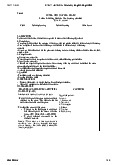

Preview text:
WRITING TASK 1: Band Descriptors (public version) Band Task achievement Coherence and cohesion Lexical resource
Grammatical range and accuracy 9
• fully satisfies all the requirements of the task
• uses cohesion in such a way that it attracts no attention • uses a wide range of vocabulary with very natural and • uses a wide range of structures with ful flexibility and
• clearly presents a ful y developed response
• skilfully manages paragraphing
sophisticated control of lexical features; rare minor errors
accuracy; rare minor errors occur only as 8slips9 occur only as 8slips9 8
• covers all requirements of the task sufficiently
• sequences information and ideas logical y
• uses a wide range of vocabulary fluently and flexibly to • uses a wide range of structures
• presents, highlights and il ustrates key features/ bul et • manages al aspects of cohesion wel convey precise meanings
• the majority of sentences are error-free
points clearly and appropriately
• uses paragraphing sufficiently and appropriately • skilfully uses uncommon lexical items but there may be • makes only very occasional errors or inappropriacies
occasional inaccuracies in word choice and collocation
• produces rare errors in spel ing and/or word formation 7
• covers the requirements of the task
• logical y organises information and ideas; there is clear • uses a sufficient range of vocabulary to allow some • uses a variety of complex structures
• (A) presents a clear overview of main trends, dif erences or progression throughout flexibility and precision
• produces frequent error-free sentences stages
• uses a range of cohesive devices appropriately although • uses less common lexical items with some awareness of • has good control of grammar and punctuation but may
• (GT) presents a clear purpose, with the tone consistent and
there may be some under-/over-use style and collocation make a few errors appropriate
• may produce occasional errors in word choice, spelling
• clearly presents and highlights key features/bul et points and/or word formation
but could be more fully extended 6
• addresses the requirements of the task
• arranges information and ideas coherently and there is a • uses an adequate range of vocabulary for the task • uses a mix of simple and complex sentence forms
• (A) presents an overview with information appropriately clear overall progression
• attempts to use less common vocabulary but with some • makes some errors in grammar and punctuation but they selected
• uses cohesive devices effectively, but cohesion within inaccuracy rarely reduce communication
• (GT) presents a purpose that is general y clear; there may
and/or between sentences may be faulty or mechanical • makes some errors in spelling and/or word formation, but be inconsistencies in tone
• may not always use referencing clearly or appropriately
they do not impede communication
• presents and adequately highlights key features/ bul et
points but details may be irrelevant, inappropriate or inaccurate 5
• generally addresses the task; the format may be • presents information with some organisation but there may • uses a limited range of vocabulary, but this is minimally • uses only a limited range of structures inappropriate in places
be a lack of overall progression adequate for the task
• attempts complex sentences but these tend to be less
• (A) recounts detail mechanical y with no clear overview; • makes inadequate, inaccurate or over-use of cohesive • may make noticeable errors in spelling and/or word
accurate than simple sentences
there may be no data to support the description devices
formation that may cause some difficulty for the reader • may make frequent grammatical errors and punctuation
• (GT) may present a purpose for the letter that is unclear at • may be repetitive because of lack of referencing and
may be faulty; errors can cause some difficulty for the
times; the tone may be variable and sometimes substitution reader inappropriate
• presents, but inadequately covers, key features/ bul et
points; there may be a tendency to focus on details 4
• attempts to address the task but does not cover all key • presents information and ideas but these are not arranged • uses only basic vocabulary which may be used repetitively • uses only a very limited range of structures with only rare
features/bullet points; the format may be inappropriate
coherently and there is no clear progression in the
or which may be inappropriate for the task use of subordinate clauses
• (GT) fails to clearly explain the purpose of the let er; the response
• has limited control of word formation and/or spelling • some structures are accurate but errors predominate, and tone may be inappropriate
• uses some basic cohesive devices but these may be • errors may cause strain for the reader punctuation is often faulty
• may confuse key features/bul et points with detail; parts inaccurate or repetitive
may be unclear, irrelevant, repetitive or inaccurate 3
• fails to address the task, which may have been completely • does not organise ideas logical y
• uses only a very limited range of words and expressions • attempts sentence forms but errors in grammar and misunderstood
• may use a very limited range of cohesive devices, and
with very limited control of word formation and/or spel ing
punctuation predominate and distort the meaning
• presents limited ideas which may be largely
those used may not indicate a logical relationship between • errors may severely distort the message irrelevant/repetitive ideas 2
• answer is barely related to the task
• has very little control of organisational features • uses an extremely limited range of vocabulary; essential y • cannot use sentence forms except in memorised phrases
no control of word formation and/or spelling 1
• answer is completely unrelated to the task
• fails to communicate any message
• can only use a few isolated words
• cannot use sentence forms at al 0 • does not attend
• does not attempt the task in any way
• writes a totally memorised response
(A) Academic │(GT) General Training
IELTS is jointly owned by the British Council, IDP: IELTS Australia and Cambridge English Language Assessment. Page 1 of 1




